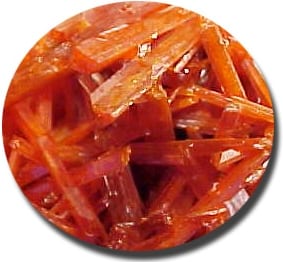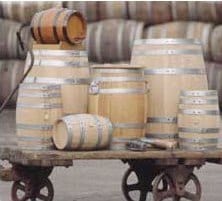Hidden in Plain Sight

Beginning with the use of chrome plating in the art deco designs of the 1930s through its heyday in the cars, furniture and appliances of the 1950s and 1960s, chromium has been closely associated with the fast-paced modern world. Unlike other metals, chromium had no ancient or prehistoric uses.
High amounts of chromium are found naturally in two minerals. The more common, called chromite, is a dark, dull stone that was easily overlooked. The second, a mineral called crocoite, is unusual in appearance but extremely rare. Crocoite, also known as lead chromate, was discovered by a geologist in 1765 at the Beresof mine near Ekaterinburg, Siberia. A brilliant orange, the mineral was prized by early stone collectors for its four-sided crystals. Artists also treasured fragments of crocoite for their beautiful, reddish orange color. But the ore is too rare to be useful commercially. Chromite, the primary commercial ore, was not discovered until 1798.
All the Colors of the Rainbow
The chromium element was isolated in 1797 by the French chemist Louis Nicholas Vauquelin. He named the element from the Greek word for color, “chroma,” because each chromium compound he produced was a brilliant color. He found reds, bright yellows and deep greens and discovered that traces of chromium in a Peruvian emerald were responsible for its color. Others later discovered that the ruby also takes its red color from chromium.
In 1799, a German chemist living in Paris found chromium in a dark, dull stone that would become to be called chromite. This mineral was more plentiful than crocoite and the greater availability of chromium facilitated innovation and discovery in a wide range of industries.
The Princess and the Carriage
The colorful chromium chemicals for which Vauquelin named chromium soon found practical application in the textile industry. Before the advent of synthetic dyes, all dyes came from natural sources such as minerals and plants. Often these dyes faded quickly if the dyed material was laundered. To fix or stabilize the color, chemical agents called mordants were used. Chemically, the mordant binds with the dye and the fibers of the material, preventing bleeding and fading. As early as 1820 the cotton and wool industries were using large amounts of chromium compounds such as potassium bichromate in the dyeing process. Red and green pigments developed from chromium compounds were also used for printing wallpaper during this period.
In 1822 one of Vauquelin’s pupils, Andreas Kurtz, moved to England and began producing potassium bichromate and selling it to the English textile industry at 5 shillings a pound. Local manufacturers soon followed suit and competition drove the price down to 8 pence, about an eighth of the original price. This did not give Kurtz a satisfactory profit, so he began producing other chrome compounds, specifically chrome pigments. His chrome yellow achieved vogue status when the popular Princess Charlotte, daughter of British monarch George IV, had it used to paint her carriage. This was perhaps the origin of the “yellow cab,” an idea exemplified today in New York City taxis. Kurtz left his mark on the world of color; “Kurtz yellow” is still available in British color catalogues.
Alloy for a Better Iron
While chromium chemicals gained commercial importance rapidly in the pigment industries, chromium took longer to make an impression on other sectors. One of these areas was the metallurgical – metal manufacturing – industry. Beginning in the mid-1800s, iron manufacturers discovered that adding chromium to steel produced a harder, more useful metal.
Steel is a mixture of iron with a small amount of carbon – around 1 percent. Such mixtures of metals are called alloys. Iron, in its pure form, can be heated and then bent, hammered or “wrought” into many forms. Iron objects produced this way are only moderately hard, and they can bend in use. Melting iron and pouring it into molds produces “cast iron” products that are brittle once they cool. But adding carbon to iron changes its microstructure and properties. When this mixture is heated it reaches an extremely ductile stage and can be formed easily. As steel cools it gains strength and rigidity, becoming stronger than iron. This process is called tempering. Different amounts of carbon and the rate of cooling determine the final properties of steel.
Adding chromium to this mixture produces a harder steel by delaying the transformation that occurs as steel is cooled, and steels with 3 to 5 percent chromium were produced beginning in 1865. It was not until the early 1900s that the corrosion resistant-properties of steels containing percentages of chromium higher than 5 percent were noticed. At higher percentages, chromium makes steel highly resistant to many corrosive agents and environments. These “stainless” steels have many applications in materials requiring high strength and resistance to corrosion. Perhaps the most well known uses of stainless steel are in cutlery and cookware. The stamp “18-8” for example indicates that the steel contains 18 percent chromium (for strength) and 8 percent nickel (for sheen). Today the use of chromium in the production of stainless steel accounts for 60 percent of chromium consumption. Stainless steel utensils and cutlery are found in kitchens throughout the United States
Toasters to Bumpers: Chrome is King
Kitchens contain chromium in another form: electroplated chromium covers sink fixtures and appliances in a mirror-like film. The ubiquity of electroplated chromium is impressive given that the fundamental principles of chromium electroplating were not discovered until 1924. The investigation began far earlier in France with Antoine Cesar Becquerel’s book on electrochemistry published in 1843. He suggested that chromium could be deposited on surfaces submerged in solutions of chromium chloride and chromium sulfate. In 1849, a Frenchman obtained a patent for a process that made gold adhere to iron with an intermediate chromium plate. R. W. von Bunsen, inventor of the Bunsen burner, investigated chromium electroplating and produced small samples of electro-deposited chromium in 1854 from chromium chloride solutions.
Most metals plate from salts (chloride and sulfate compounds) but chromium is unusual in that it plates best from chromic acids. Early experimenters tried chromium chloride and sulfate solutions with little success. The correct solution was discovered by chance when a German professor electrolyzed a chromic acid solution and noticed a deposit of chromium. This surprising discovery led to research by Colin G. Fink and several graduate students from Cornell and Columbia that explicated the process.
The first application of chrome plating was in the production of jewelry. Chrome was used to plate solid-platinum wedding rings to protect them from wear. Hailed as a miracle metal that looked like platinum but wore much better, chrome-plated jewelry was soon on the ear and hand of fashionable woman across the United States.
As the plating process became cheaper and more common, plumbing fixtures and household appliances were plated with chrome. The attractive shiny surface and the resistance to corrosion made plated articles aesthetically and functionally desirable. Soon consumers were demanding chrome trim on all their appliances, and car manufacturers began making the chrome bumpers and molding so characteristic of 1950s auto designs. “Chrome,” virtually unknown 30 years before, had become a household word.
Industrial applications for chrome plating were being discovered at the same time that decorative chrome plating was making its flashy debut. Chrome is a very hard metal and has a low coefficient of friction. Manufacturers started plating machine parts such as car cylinders that received a lot of wear with a thick layer of chromium, extending the life of these parts considerably. Chrome was also useful in boiler pipes. Pipes made of steel would build up scale – mineral deposits released by boiling water – and the deposits would flake off the surface of the pipe and clog the system. Chromium plated pipes, however, did not release the scale. Copper and steel plates used for printing money wore out quickly before the advent of chromium plating, but with a layer of chrome they could produce crisp images for a much longer time.
The widespread use of chromium in these applications has made it difficult to measure the amount of chromium in the environment, in foods and in human tissue. Scientists use extremely rigorous metal-free “clean” techniques to measure trace levels of chromium accurately. But the chromium in stainless steel laboratory equipment and other products can easily contaminate samples that are not stored, processed or analyzed properly.
Too Hot to Handle: Refractory Materials
Chromium steel, which resists warping or melting under conditions of extreme heat, is ideal for high-temperature applications such as jet-engine components. The principle chromium ore, chromite, is heat resistant in the same way. It is this property, along with its chemical stability, that makes chromium useful as a refractory material.
Refractory materials are used as insulation to line the inside of blast furnaces and crucibles used in metal manufacturing, especially in refining metals and making steel and other alloys. Alloys are made when two or more metals are mixed together to produce a new metal that combines desirable characteristics, such as hardness and resistance to corrosive environments.

Blast furnaces are tall cylindrical towers with a crucible, a large bowl-shaped structure, at the bottom and a slightly tapering top. A mixture of ore and other materials (the charge) is loaded into the top of the furnace and hot air is blown up from the bottom. Chemical reactions in the charge separate the metal from the waste product (slag) and the purified metal collects in the crucible. Usually the slag floats on top and the metal is poured from a spout in the bottom of the crucible.
While in operation the blast furnaces are extremely hot. These high temperatures are necessary to facilitate the chemical reactions that separate metal from ore. But this heat could potentially enable the ore to react with materials in the walls of the blast furnace and the lining of the crucible, contaminating the metal being refined. And if the walls expand under this heat, the structural integrity of the tower could be challenged. For these reasons, the walls must have an appropriate chemical composition. Standard building materials like concrete and cement cannot stand up to these conditions and clearly any steel used in the building must be shielded or it will melt like the metal inside the furnace.
For these reasons, refractories are indispensable to the steel-making process. Refractories, or refractory materials, have high melting points and are chemically stable. This makes them ideal for insulating blast furnaces that extract pig iron from iron ore and for lining the large crucibles that hold molten steel.
Chromite was initially used as a refractory in France along with magnesite and dolomite (other refractory minerals). Up until the 1890s, bricks of solid chromite cut straight from the mine were used without further refinement or processing. These are called dressed blocks of ore.
As the steel industry grew in the US and England, manufacturers developed refractory bricks made of crushed chromite or magnesite. These were cheaper to manufacture than the dressed blocks because broken pieces of ore were as useful as the large solid blocks required for dressing. The crushed ore was mixed with a resin and pressed into brick shapes. Alternatively, they were fired at low temperatures like clay. In the 1930s refractories made from mixtures of chromite and magnesite in various percentages were produced for different applications. In 2000, four million metric tons of chromite were mined worldwide. The US consumes around 90,000 tons a year. In 1982, 11 percent of chromite was used in refractory materials, but in 1989 the proportion had dropped to 7 percent.
Because of technological advances, chromite is less important today as a refractory than it was at the beginning of the 20th century. However, it is still irreplaceable as the critical alloy in stainless steel. Even before the value of chromium in steel-making was widely appreciated, the discovery of the ore in the United States made one family extremely wealthy and established the country as a leader in the chrome industry.
The American Chrome Tycoon
With the advent of these chromium-based industries, chromium ore was in high demand. Up until about 1830, the majority of the world’s chromite came from Siberia, where Pallas first found crocoite. As an amateur geologist, Isaac Tyson was one of few Americans who had studied chromite and knew its value and its commercial potential.
In the summer of 1827, he was standing in a Baltimore marketplace when he noticed a cart carrying barrels of apple cider. Heavy black stones were wedged between the barrels to keep them from rolling. He had studied similar stones six miles from Baltimore near his father’s home and he recognized these rocks as the mineral chromite. Intrigued, Tyson quickly found that the stones originated from the Reed farm, 27 miles northeast of Baltimore in Harford County. Tyson bought the farm and soon found a large pocket of chromite ore eight feet below the earth’s surface. Convinced that the Baltimore area held more ore, he searched in wider and wider circles. His hunch was right; in 1828 he found ore on the Wood farm in Pennsylvania.
Tyson turned the property into the Wood mine, which eventually yielded 100,000 tons of ore. Soon, Tyson owned mineral rights on all the ore-bearing sites in Pennsylvania, Virginia and Maryland. As the Siberian deposits waned, his company enjoyed a growing international monopoly in chromium ore. However, when chromium was discovered in Turkey in 1848, Tyson lost his monopoly. Like Kurtz in England, he turned to other products and began producing chromium chemicals for the textile industry. In this way, he became a pioneer of the U.S. chemical industry.
Cancer Risk in the Workplace?
Most commercial uses of chromium require the form chromium+6, which is produced from chromite (chromium+3) through a chemical roasting process in which chromite ore is crushed and heated with reactive chemicals. This process produces a great deal of dust and air-born chromium. Unfortunately, it was the workers in these industries that discovered first-hand the health risks associated with air-borne chromium dusts.
During the first half of the 20th century, dust levels in the air during ore processing were so high it was said that one could not see the opposite wall across the factory floor during peak production hours. Workers were breathing dusts containing a very high level of airborne chromium.
In the 1930s, industrial hygienists in Germany began to notice that the incidence of respiratory cancers such as lung cancer was higher for workers in the chrome ore industry than for other similar occupations. In autopsies years later, the lungs of workers exposed to these dusts over a lifetime were shown to contain as much as 10 percent chromium by weight. Cigarette smoking was uncommon in the general population between 1900 and 1940 and lung cancer was still relatively rare in middle-aged men. Physicians therefore noted the increased lung disease in these workers as being unusual.
Based on these observations, the Germans began a series of steps to reduce dust levels and personal exposure in the chromium industry, marking the beginnings of what are now modern industrial hygiene practices. The onset of World War II kept these observations from becoming widely disseminated or adopted by other countries, but after the war the rest of the western world began to investigate chromium-related illness and to initiate their own industrial hygiene programs.
Landmark epidemiology studies of occupational chromium exposure in the 1950s and 1960s found that exposure to dusts containing the industrially produced chromium+6, rather than the chromium+3 found naturally in the ores, was associated with lung cancer. These studies also suggested that certain forms of chromium dust, particularly compounds of intermediate solubility in water such as calcium chromate, were of greatest concern. The most water-soluble forms such as sodium or potassium chromate and the highly insoluble forms such as lead chromate were not closely associated with health effects.
During this period there was a concerted effort to reduce worker exposure, by altering manufacturing processes, substituting forms of chromium, using personal protective clothing, and other measures. Government agencies set acceptable levels for exposure, which were continually revised as new information was gained from additional studies. This led to greatly reduced dust levels and reduced worker exposure. Recent studies indicate that workers who began in these industries from the 1960s on, after these practices were in place, have levels of respiratory cancer that are not significantly different from the general population.
Chromium on the Silver Screen
In the film Erin Brockovich (2001, Universal Studios) Pacific Gas and Electric is portrayed as a corporate giant that poisoned the water of the small town of Hinkley, California. The movie, which is based on a real lawsuit, suggests that high levels of chromium-6 were responsible for an eclectic range of diseases among residents there, including various cancers, miscarriages, Hodgkin’s disease and nosebleeds.
In the 1960s PG&E was using sodium dichromate, a chromium-6 compound, as a rust preventative in coolant fluids. Modern petrochemical plants and refineries have large cooling towers that remove excess heat produced by generators, refrigerating units and other machines. Over time, coolant fluids in the towers can accumulate corrosion or mineral deposits. These build-ups decrease plant efficiency, making it necessary to halt production for lengthy and expensive cleanings. However, adding sodium dichromate to the coolant fluid almost eliminates corrosion and mineral build-up.
Over time, sodium dichromate degrades to chromium+3. As this happens, the solution becomes less and less effective as a rust preventative. As a result, PG&E soon accumulated a large amount of waste coolant. The company put the waste in shallow ponds, intending to dredge the chromium waste from the bottom of the pond when the rest of the solution evaporated. However, the sandy desert geology was not taken into consideration. The coolant quickly seeped into the ground, and the chromium contaminated the groundwater that feeds the wells of Hinkley.
Today, levels of chromium+6 are higher than normal in some Hinkley wells. Could this compound have adverse health effects?
The respiratory cancers and related illnesses seen in chromium ore workers in the early 20th century are the only well-documented ill effects associated with exposure to chromium. No other adverse effects of drinking water exposure to chromium in humans or experimental animals have been reported by national or international groups such as the U.S. Environmental Protection Agency, the U.S. Centers for Disease Control and Prevention, the World Health Organization or the International Agency for Research on Cancer.
Partly in response to the lawsuit upon which the Erin Brockovich movie was based, California recently considered lowering the allowable amount of chromium in drinking water. However, an expert panel convened by the California Environmental Protection Agency to review this decision concluded in their report that the current standard is protective of human health and that there is no evidence of increased risk of disease from chromium in drinking water. Other independent studies of Hinkley and other California towns with similar cooling towers indicate no increase in cancer in these towns over the period of exposure.
Essential for Life
Like vitamins and minerals including iron, calcium, zinc and selenium, chromium is an essential trace element – we need it in our diet for normal health. Most daily vitamin formulations contain between 50 and 200 micrograms of chromium. But how do we know that something like chromium is essential for health?
Studies in the 1950s suggested that chromium might be involved in regulating levels of glucose in our blood. Glucose is the sugar our bodies use for fuel. Blood glucose levels are primarily regulated through the release of insulin. Lack of proper glucose control by insulin is the basis for diabetes. Animal studies conducted in the 1960s by Dartmouth researcher Henry Schroeder demonstrated that chromium was required for normal glucose regulation, at least in experimental animals. This was demonstrated by first taking chromium completely out of the diet, which caused a diabetes-like glucose problem in the animals, and then adding chromium back into the diet, which eliminated the problem. This basic experiment is how most of the essential dietary substances have been demonstrated to be required for normal health.
Of course, the ultimate scientific proof would be direct evidence that a substance is essential in human beings (such as the British scurvy observations), and this evidence was lacking for chromium for many years. However, in the 1970s, a young doctor did a bold and unusual experiment to help a young woman who was in a coma. The woman was unable to eat or drink, so she was on total parenteral nutrition or TPN; in other words, all her nutrition was given to her through an intravenous tube from a plastic bag containing sugar, amino acids and other nutrients. Over many weeks, she developed a diabetes-like condition that did not respond to injections of insulin as might be expected. The doctor treating her had read about animal studies with chromium and decided to try adding chromium+3 to her TPN bag. Within days her diabetic condition completely disappeared. This observation was repeated in several other patients, demonstrating directly in humans the need for chromium+3 for normal glucose regulation. Chromium is now a standard ingredient in TPN and other artificial diets.
Most studies suggest that we get all the chromium we need from a normal, well-balanced diet of meat, grains, fruit and vegetables. However, supplementation has been shown to be beneficial for diabetics and others with glucose regulation imbalances, in the elderly and in those with poor nutrition.
Sources Include:
WebElements Periodic Table Includes extensive information on the chemical properties of lead, from the simple to the complex. Designed for students and for curious, somewhat science-savvy citizens.
Chromium, Vols. 1 and 2, Udy, Martin J., ed. Reinhold Pub. Co., New York 1956.
Kirk-Othmer Encyclopedia of Chemical Technology. 4th Edition. Vol. 3, pg 820- 875. Wiley & Sons, New York 1998.
Written by:
Erik Jacobson Science Writing Intern





